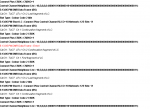Hello,
I can receive 26 Connect Plus sites on 900 MHz alone, with good quality on most. There are two networks with users busy even on weekends. The local systems on VHF/UHF are single site and not as busy.
It is fortunate Motorola decided to use some standard DMR messages as it helps figure out what is going on. I spotted some Unit-to-Unit Voice Headers on a traffic channel and was able to figure out the indicating bit in the Voice GoTo Message. The last bit of the CSBK Voice GoTo message (the bit just before the CSBK CRC) is 1 when it is an unit-to-unit call, and the "Group" value is a radio id.
I wonder if this is part of a call type field with 2 being a group call and 3 being an unit-to-unit call? This is different than the DMR Trunking Standard where they use different CSBKs for group and unit-to-unit calls.
The Connect Plus System Planner mentions 16776352 through 16776415 are not usable as radio IDs (0xFFFCA0 through 0xFFFCDF). The reason is system devices are assigned those addresses. I noticed 16776410 (0xFFFCDA) is involved in sending and receiving data over the system. I added code to dsd that decodes the data headers. My two local 900 systems are using IP Protocol and 16776410 is sending data and responses to radios. It appears some CSBKs on the traffic channel are used for supervisory control of the data transmissions.
73 Eric
I can receive 26 Connect Plus sites on 900 MHz alone, with good quality on most. There are two networks with users busy even on weekends. The local systems on VHF/UHF are single site and not as busy.
It is fortunate Motorola decided to use some standard DMR messages as it helps figure out what is going on. I spotted some Unit-to-Unit Voice Headers on a traffic channel and was able to figure out the indicating bit in the Voice GoTo Message. The last bit of the CSBK Voice GoTo message (the bit just before the CSBK CRC) is 1 when it is an unit-to-unit call, and the "Group" value is a radio id.
Code:
CSBK lb:1 pf:0 MtCon+ Voice GoTo CId:001F66 Grp:001F41 LCN:1 Slot:B ?:00000000011 On Slot A of the control channel
VOICE Header pf:0 UU V Ch Usr DRId:0x001F66 CRId:0x001F41 On Slot B of the control channel
voice frames
TLC pf:0 UU V Ch Usr DRId:0x001F66 CRId:0x001F41 On Slot B of the control channelThe Connect Plus System Planner mentions 16776352 through 16776415 are not usable as radio IDs (0xFFFCA0 through 0xFFFCDF). The reason is system devices are assigned those addresses. I noticed 16776410 (0xFFFCDA) is involved in sending and receiving data over the system. I added code to dsd that decodes the data headers. My two local 900 systems are using IP Protocol and 16776410 is sending data and responses to radios. It appears some CSBKs on the traffic channel are used for supervisory control of the data transmissions.
73 Eric


